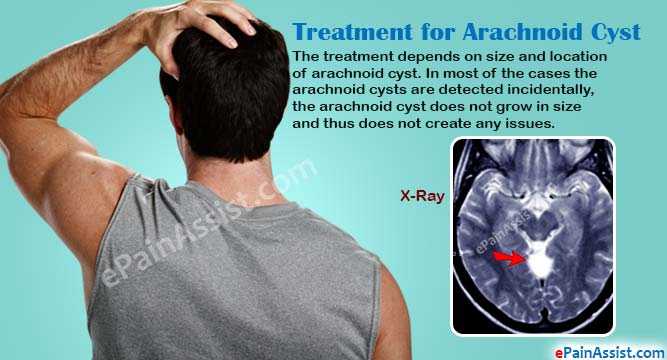There is a continuous debate on the treatment approach for arachnoid cyst; the treatment approach for arachnoid cyst majorly depends on the size of the arachnoid cyst and the location of the arachnoid cyst.

This article explains about the treatment for arachnoid cyst, risk factors, complications and recovery period for arachnoid cyst.
Treatment for Arachnoid Cyst
The treatment for arachnoid cyst depends on size and location of arachnoid cyst. In most of the cases the arachnoid cysts are detected incidentally, the arachnoid cyst does not grow in size and thus does not create any issues. Thus, most of the professionals prefer not to start any treatment until the symptoms starts to show and prefer to keep a close watch on the arachnoid cyst.
The therapy used for the treatment of the arachnoid cyst depends on various factors like occurrence of symptoms, size of the arachnoid cyst and the particular part of skull where arachnoid cyst formation takes place.
The therapy procedures followed for the treatment when necessary can be done by open craniotomy fenestration.
In open craniotomy fenestration for treating arachnoid cyst, the surgeon first creates a small hole in the skull to operate the portion containing arachnoid cyst. Then he would make space by creating some opening to let the CSF (cerebrospinal fluid) to leak into the subarachnoid space so that the fluid can be easily absorbed. In an alternate approach, the surgeon would use a device to drill into the cyst and let the CSF leak into the abdominal cavity or into the ventricular system from where the CSF or cerebrospinal fluid can circulate normally.
With the advancement in the technology, the traditional procedures have undergone significant improvements using endoscopic techniques and have resulted into faster, safer and less complicated surgeries. Even the recovery is faster with such advanced techniques. The use of endoscopy depends on the size and location of arachnoid cyst. The endoscopic surgeries have made the job easier whether it is fenestration or anything else. Also the risk factor related to retraction and brain manipulation has reduced significantly with endoscopy. However there are only few facilities where you can avail these advanced techniques involving endoscopic shunt placement, endoscope assisted fenestrations, endoscopic resection of arachnoid cysts etc.
The arachnoid cysts in spinal cord can be fully treated by removing the arachnoid cyst using surgery and it also ends all the symptoms of arachnoid cyst. If the arachnoid cyst cannot be removed completely using surgical methods, fenestration or shunting approach is adopted to let the CSF or cerebrospinal fluid to leak out. There are some other treatments, which do not involve surgeries and are given according to the symptoms.
Risk Factors for Arachnoid Cyst
There are multiple risk factors for arachnoid cyst. Males are more prone to arachnoid cysts as compared to females. However, reports suggest that all age groups and all races are equally prone to arachnoid cysts irrespective of the geographical location. There are more cases of intracranial cysts as compared to spinal arachnoid cysts. As the arachnoid cysts do not show any clear symptoms, the exact number of people suffering with this problem is still unknown.
However, there are certain factors that can make you more prone to but not necessarily cause arachnoid cysts. Some of these risk factors for arachnoid cyst are as follows:
- Brain or spinal cord tumor is a risk factor for arachnoid cyst.
- Another factor of risk for arachnoid cyst is brain or spinal cord surgery.
- Head injury.
- Brain infection such as meningitis (infection or inflammation of the sac around the brain and spinal cord.)
- Male gender.
Complications in Arachnoid Cyst
There can be complications in arachnoid cyst. One can avoid the serious symptoms of arachnoid cysts if the issue is detected early and treatment can be started in time. In case of any delay, the arachnoid cyst starts to grow larger and puts pressure on brain and spinal cord, which can result in permanent neurological complications. If the arachnoid cyst is not treated in time, it can get severe and can even be fatal in extreme cases.
The complications of arachnoid cyst can be easily avoided by sticking to the proper health care routine that is recommended by your doctor. Following is the list of the complications for arachnoid cyst:
- Hydrocephalus (fluid buildup in the skull) is a likely complication in arachnoid cyst.
- Seizures and tremors.
- Permanent nerve damage including paralysis.
- Brain damage.
- Failure to thrive in infants and children.
Recovery Period or Healing Time for Arachnoid Cyst
The time that an individual would need to recover or the recovery period/healing time for arachnoid cyst completely varies according to the type of treatment and is not specifically defined. The doctor can tell you an approximate recovery time after the proper examination of cyst. Thus, it is recommended to refer to the doctor for any queries related to the recovery.
- “Arachnoid Cyst: Risk Factors and Complications” – National Institutes of Health (NIH) Link: https://www.ncbi.nlm.nih.gov/pmc/articles/PMC4194222/
- What are arachnoid cysts?: https://my.clevelandclinic.org/health/articles/6023-arachnoid-cysts#:~:text=Many%20arachnoid%20cysts%20don’t%20cause%20symptoms%20and%20don’t,Symptoms%20usually%20improve%20after%20treatment.
- Arachnoid Cysts: https://www.ncbi.nlm.nih.gov/books/NBK563272/
Also Read:
